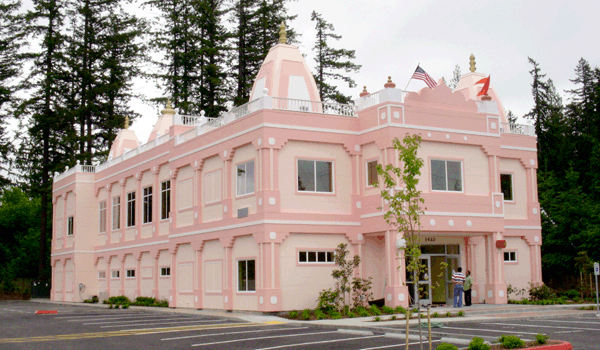Temple Profile: Seattle
By Madhava Smullen | Apr 16, 2010

Name: Vedic Cultural Center and Sri Sri Radha Nila Madhava Temple
Address: 1420 228 Ave SE Sammamish, WA 98075
Phone: Hari Vilas Dasa at (425) 246 8436; Nanda Suta Das at (206) 992 7598
Website: http://www.vedicculturalcenter.org
Presiding Deities: Radha-Nila Madhava, Gaura-Nitai, and Sita-Rama.
President: Hari Vilas Dasa
Opened on: July 6, 2008
Temple Style: Two-storey custom-built Indian-style temple, with temple room upstairs and prasadam hall downstairs.
Location: Upper middle class suburb, many residents working in the IT industry, large Indian community, low-crime area.
Distinctive food offerings: South Indian dishes including payasam—a sweet rice dish, dosa, idli, sambar, and coconut chutney.
Number of residents: The temple’s minimal residential facilities house only the deities’ three priests. However, 25 families, mostly initiated, live nearby.
Number of visitors: Approx. 2,500 per week.
Best time of year to visit: Summer. Nicer weather, and four major festivals plus two Ratha Yatras.
When temple president Hari Vilasa Dasa took up the challenge of reviving ISKCON Seattle in 1991, the community—which ISKCON had established as only its fourth project in the United States back in 1968—was on the verge of collapse. The once thriving temple had been moved to an obscure suburb called Issaquah, and the few devotees that remained were struggling to deal with a dramatic variety of problems including termite infestation, a septic tank failure, and accrued mortgage payments.
Hari Vilasa’s first move was to shift the outreach focus from proselytizing to developing good behavior, listening skills, and empathy, thus convincing by example. When Seattle devotees also made their approach more accessible, by removing confusing ISKCON buzz words from their vocabulary and increasing cultural presentations, a whole new crop of visitors began to show interest.
Within the next few years—as if by Krishna’s hand—a rapidly developing new town called Sammamish grew around the temple, suddenly turning the area into one of the most desirable places to live in Seattle, and quickly becoming the hub of the Hindu community.
Today, the brand new Vedic Cultural Center and Sri Sri Radha Nila Madhava temple sits just across from Sammamish City Hall. With its Indian architecture and pink sandstone color, the impressive two-storey building draws intrigued looks from the 20,000 people that drive by it every day.
And there are plenty of reasons for them to visit, with the Vedic Cultural Center reaching out to its community in an almost endless list of ways. The question to ask about this temple is not what it does, but what it doesn’t do.
There’s Children of Faith, a program that invites children of all faiths—Hindu, Muslim, Christian, Baha’ai, Sikh, and more—to express their religious beliefs through song, dance, art, poetry and other culturally expressive mediums. There’s Priyam Vacha, a spiritualized Toastmasters-style public speaking forum. There are classes on singing, dancing, tabla, yoga, languages, and cooking. And there are both introductory and in-depth Vedic University Classes that offer formal training in Srila Prabhupada’s books of spiritual wisdom. Most of these are held weekly.
“We also have Saturday Movie Night, where we serve pizza and popcorn and show Disney-quality animated movies about Krishna, and other Krishna-related films,” says Hari Vilasa. “That’s of course very popular with both children and parents alike.”
In addition to its traditional temple festivals, the Vedic Cultural Center also holds events for its community, such as summer’s three-day Ananda Mela, supported by and held in the City of Redmond, an upscale suburb of Seattle. With the byline “A Cultural Journey to India,” it will include an audio-visual temple tour of India’s architectural wonders; educational exhibits based on the philosophy of the Vedas; a prasadam food booth; children’s rides and activities, and entertainment on two performance stages. The festival draws 10 to 20,000 people.
Other annual festivals include “Kumbha Mela,” held at the temple back-to-back with Krishna’s appearance day, and two seaside Ratha Yatras, while devotees will also have a presence at the local Freemont Fair, reaching a quarter of a million people.
The Vedic Cultural Center also engages in activities that are purely social welfare: Its completely free vegetarian restaurant, My Sweet Lord, has served Seattle for eight years. Meanwhile, its Mercy Meals program delivers hot food straight to peoples’ houses, and a newly launched program offers free tutoring in math, science and English to underprivileged children.
All these programs make the temple eligible for grants from major corporations such as Microsoft, Amazon and Google, as well as attracting help from many idealistic volunteers of both American and Indian backgrounds.
“As is our practice, we do not preach to them,” says Hari Vilasa. “But as they associate with us, those who are interested naturally ask questions and find out more about Krishna consciousness.”
While some have criticized ISKCON Seattle’s style of outreach-by-example instead of direct “preaching,” the community is obviously doing something right.
Its current temple building will soon be expanding a further 1,200 square feet, while new hand-carved altars and new larger Deities of Sita, Rama, Lakshman and Hanuman are on their way.
There are also plans to begin building work on a second major temple in the Seattle area within the next year, this time in Bellevue, home of Microsoft. The projected complex will include a temple, a performing arts center with an auditorium, a convention hall, a catering service, and a restaurant.
The future is bright for the once fading ISKCON Seattle—now one of the biggest success stories in ISKCON North America.















